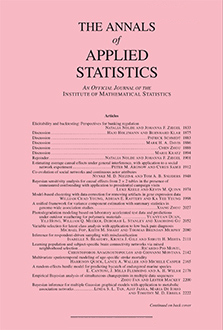Abstract
Most radiotracers used in dynamic positron emission tomography (PET) scanning act in a linear time-invariant fashion so that the measured time-course data are a convolution between the time course of the tracer in the arterial supply and the local tissue impulse response, known as the tissue residue function. In statistical terms the residue is a life table for the transit time of injected radiotracer atoms. The residue provides a description of the tracer kinetic information measurable by a dynamic PET scan. Decomposition of the residue function allows separation of rapid vascular kinetics from slower blood-tissue exchanges and tissue retention. For voxel-level analysis, we propose that residues be modeled by mixtures of nonparametrically derived basis residues obtained by segmentation of the full data volume. Spatial and temporal aspects of diagnostics associated with voxel-level model fitting are emphasized. Illustrative examples, some involving cancer imaging studies, are presented. Data from cerebral PET scanning with $^{18}\mathrm{F}$ fluoro-deoxyglucose (FDG) and $^{15}\mathrm{O}$ water (H2O) in normal subjects is used to evaluate the approach. Cross-validation is used to make regional comparisons between residues estimated using adaptive mixture models with more conventional compartmental modeling techniques. Simulations studies are used to theoretically examine mean square error performance and to explore the benefit of voxel-level analysis when the primary interest is a statistical summary of regional kinetics. The work highlights the contribution that multivariate analysis tools and life-table concepts can make in the recovery of local metabolic information from dynamic PET studies, particularly ones in which the assumptions of compartmental-like models, with residues that are sums of exponentials, might not be certain.
Citation
Finbarr O’Sullivan. Mark Muzi. David A. Mankoff. Janet F. Eary. Alexander M. Spence. Kenneth A. Krohn. "Voxel-level mapping of tracer kinetics in PET studies: A statistical approach emphasizing tissue life tables." Ann. Appl. Stat. 8 (2) 1065 - 1094, June 2014. https://doi.org/10.1214/14-AOAS732





